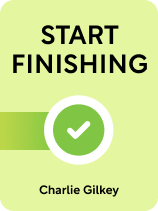

This article is an excerpt from the Shortform book guide to "Start Finishing" by Charlie Gilkey. Shortform has the world's best summaries and analyses of books you should be reading.
Like this article? Sign up for a free trial here.
How can you overcome the gap between generating ideas and actually accomplishing them? What separates ordinary projects from those that truly matter?
In his book Start Finishing, Charlie Gilkey explores how to turn ideas into reality through concrete planning and meaningful commitment. He distinguishes between regular projects and authentic projects—work that aligns with your unique talents and creates positive change.
Read more to learn about overcoming psychological barriers, intentionally curating your project list, and strategically deciding which endeavors deserve your full attention.
Turning Ideas Into Reality
Gilkey begins his book by exploring the fundamental human struggle between goals and achievements: Many people find themselves trapped in a cycle of having meaningful and exciting ideas, but they never seem to make progress on them. This happens because ideas aren’t things that can be completed—you must first turn them into projects with concrete objectives and endpoints.
Gilkey explains how to turn ideas into reality—distinguishing projects from authentic projects, identifying roadblocks that may be stopping you from starting or finishing an important project, and stressing the importance of committing yourself fully to a project.
(Shortform note: The reason you can’t “do” an idea—which is really a goal without a plan—is that it lacks specific, actionable steps. Studies in neuroscience have found that complex actions, such as working toward a long-term goal, have both emotional and intellectual prerequisites. What Gilkey describes here is a situation where you’ve met the emotional requirement (you’re motivated to realize your dream) but not the intellectual one. In much simpler terms, you can’t act on your idea because you haven’t yet figured out how to do that.)
Projects and Authentic Projects
Gilkey defines a project as any endeavor that takes a significant amount of time, effort, and focus to complete. For example, in a professional setting, compiling a weekly report isn’t really a project (it would be more accurate to call it a task). However, earning a promotion could be a project if that’s a goal you consistently work toward.
While Gilkey’s methods can empower you to complete any kind of project, he adds that not all projects are created equal. Realizing your full potential, and thereby finding success and happiness in life, requires you to finish authentic projects. This means doing work that’s deeply meaningful to you, aligned with your unique talents and passions, and with the potential to make a positive change in the world.
Also note that authentic projects don’t only exist in professional settings. You can design such projects in any area of your life, from personal creative pursuits to community initiatives like a neighborhood cleanup crew. In short, any goal with deep personal significance is a chance to create an authentic project.
| Find Authentic Projects in Your “Productivity Zone” In Free to Focus, leadership and productivity expert Michael Hyatt presents a simple framework that can help you determine which projects align most closely with your unique passions and abilities. He recommends setting up a simple two-by-two table, then categorizing every task and project you have to do (work-related or not) based on two criteria: whether you’re interested in doing that task, and whether you’re skilled at doing it. Tasks that you’re both interested in and skilled at go into what Hyatt calls the “Productivity Zone.” He says that you should try to spend as much time as possible handling tasks in that zone, because they’re meaningful to you and you can do them well. In the context of Start Finishing, this is also where you’ll find the most likely candidates for authentic projects. To further strengthen the connection, note that Hyatt defines “productivity” specifically as doing meaningful work that gets you closer to your vision of an ideal life. In contrast, the more common definition of productivity is just getting things done, and it has nothing to do with how important those tasks are to you. This mirrors Gilkey’s concept of authentic projects—meaningful work that makes you happy and improves the world—versus “projects” as a general term for anything that you put time and effort into. |
Overcoming Psychological Barriers
In his discussion of projects and authentic projects, Gilkey identifies several mental barriers that prevent you from making progress, as well as skills you can practice to overcome them.
One common barrier to finishing projects is poor planning (or not planning at all). This causes you to become mentally paralyzed because you can’t see how to get from your project’s starting point to its end point. Gilkey also says that you may be unknowingly sabotaging yourself with negative thoughts—you’re holding yourself back with your ideas about what’s possible or what you’re capable of.
To overcome these internal roadblocks, the author urges you to practice several productivity-focused skills. The first is intentionality: being clear about what your goals are and how, specifically, you plan to achieve them. The next is self-awareness, which means building a clear understanding of your own strengths, weaknesses, habits, and limitations. The third skill is bravery, which Gilkey defines as the willingness to take action in spite of your concerns and knowing that you might fail. Finally, he suggests honing your self-control: the willpower and stamina to put forth consistent effort for however long it takes to turn a dream into a completed project.
| Hone Your Skills With Mindfulness Meditation Gilkey recommends developing several different skills in order to boost your productivity, but he doesn’t offer much advice on how to actually do so. One common practice to hone these abilities is mindfulness meditation, which teaches you how to recognize and overcome your moment-to-moment impulses. By training your self-awareness in this way, you become better able to take thoughtful, intentional action instead of reacting to every fleeting thought and feeling you experience. This practice will also help you because meditation inevitably brings up difficult or uncomfortable thoughts. Mindfulness teaches you to acknowledge such thoughts and let them fade, thereby cultivating the bravery to work through your worries and doubts. Throughout the session, when your mind wanders (which it will), gently but firmly return your attention to your breath or chosen focus point, reinforcing the self-control muscles that you’ll need for consistent long-term effort in any meaningful project. To practice mindfulness meditation, start with a daily meditation session lasting anywhere from five to 15 minutes (you can increase the time once that starts feeling too easy). Find a relatively quiet place where you won’t be disturbed, get into a comfortable sitting or lying position, then start to breathe slowly and steadily. Finally, direct your attention inward to observe your thoughts, feelings, and reactions. The key point of mindfulness meditation is to recognize and identify those inner experiences without judging them—your impulses are not “good” or “bad,” they simply are what they are. |
Choosing and Committing to a Project
Gilkey also addresses the emotional complexity of choosing and committing to a project. People instinctively understand that time is finite and that choosing to do a certain project also means choosing not to do other things with that time. This can cause you to avoid committing to any project because you’re reluctant to leave other ideas and dreams behind.
Gilkey says you can escape from that mental trap by actively and intentionally curating your project list, letting go of ideas that no longer serve your goals. Doing so involves honest self-reflection: You must think seriously about how important each of those ideas is to you, and be willing to write off the ones that don’t align with your current priorities and aspirations. Though difficult and uncomfortable, this process will allow you to give your full attention to your most important ideas.
| Tip: Try Setting Emotion-Based Goals It can be difficult to narrow down your project list through rational thought, as Gilkey suggests doing. After all, if you knew which projects were most important to you, you’d most likely have curated your list already. In The Desire Map, entrepreneur Danielle LaPorte suggests a different approach: Instead of thinking about what you want to do, decide how you want to feel. She urges you to consider what emotions you most want to experience—such as peace, inspiration, connection, or joy—and make it your goal to feel those emotions every day. You can then choose and commit to projects that spark your desired feelings, instead of relying on pure reason to decide. LaPorte argues that this emotions-based approach has some key advantages over a logic-based one. First, it allows you to enjoy working toward your goal, not just reaching it. For instance, if your goal is to be happy, pursuing that goal includes finding small things you can do every day to make yourself feel happy. Secondly, because you’ve given up on traditional ideas of “success” to pursue the things you truly want, you’re likely to be more engaged (and therefore more successful) than you were while working toward what other people had convinced you to want. |
Remember: You Can’t Give 100% to Everything
Gilkey notes that, by definition, you can’t give your all to multiple projects at the same time. However, you’ll naturally want all of your projects to succeed, whether they’re authentic projects or not. For example, you can’t just stop doing your job whenever you find something more personally meaningful to work on.
(Shortform note: Modern research shows that multitasking is a myth—it’s not even possible to work on multiple things at once, never mind giving your full attention to more than one project at a time. Furthermore, dividing your attention makes you much less efficient and less productive than allowing yourself to fully focus on one thing at a time. Therefore, you’ll be most successful if you choose just one project at a time to fully commit to. Alternatively, if you’re already caught between multiple commitments, you could set specific time blocks for each project. This will enable you to make progress toward multiple goals, yet still focus fully on one project at a time.)
To better manage your commitments and enable as many of your projects as possible to succeed, the author recommends breaking down your concept of success into three categories. The first type of success is a small success, meaning what you did was “good enough.” That is to say, your work was competent, but you’re probably not especially proud of it. A medium success means that you went beyond the bare minimum and did something you can be proud of. Finally, a great success means that you gave your all and achieved something remarkable.
Next, Gilkey offers two further insights. First, each level of success requires a proportionate amount of time and effort. So, a small success only takes a relatively small amount of time and energy, while a great success requires a great deal of both. Second, not everything needs to be a great success. It’s OK to stop at “good enough” on projects that aren’t especially meaningful to you and save your best work for authentic projects that reflect your talents and goals.
| Choose Your Great Successes Using the 80/20 Rule Gilkey encourages you to categorize your commitments in terms of the level of success you want to achieve in each project and therefore how much effort you need to devote to it. But how do you decide which projects deserve to be “great successes,” and therefore require your best efforts? In The Monk Who Sold His Ferrari, life coach Robin Sharma suggests that you allocate your efforts according to the 80/20 Rule (commonly called the Pareto Principle). This is a popular rule of thumb stating that 80% of what you achieve comes from just 20% of what you do. Therefore, if you’re having trouble deciding what to strive for great successes in, try to identify those few aspects of your life that have exceptionally large impacts on your overall happiness or well-being, and commit to projects related to those. For instance, if you’re stressed because your home is messy, and that stress makes it hard to fully enjoy a lot of what you do, it would be worthwhile to strive for great success in cleaning your house or apartment. This most likely means working at it a little bit each day until your entire home is spotless, everything is organized and put away, and you have some rules or systems in place to make sure it doesn’t get that messy again. |

———End of Preview———
Like what you just read? Read the rest of the world's best book summary and analysis of Charlie Gilkey's "Start Finishing" at Shortform.
Here's what you'll find in our full Start Finishing summary:
- How to get your big ideas out of your head and turn them into reality
- Advice for making the most of your limited time and resources
- Steps to take after you've successfully completed a project






